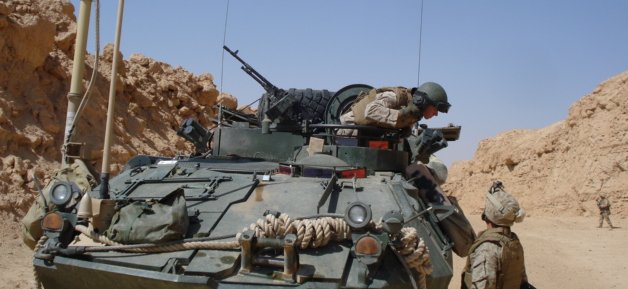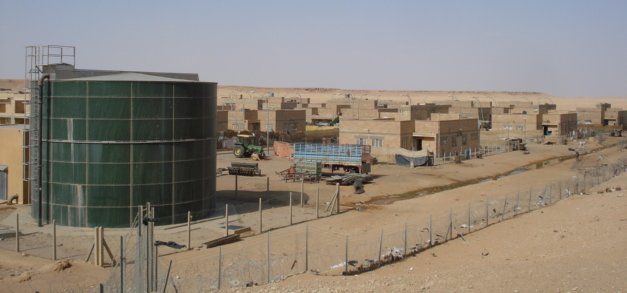I was worried that Akashat was a place I would never see. This would have kept me in the company of almost everybody else on earth with the only difference being that I wanted to go. I planned to go to Akashat on a couple of occasions and ran into bad weather. I went to Akashat today. Hallelujah. Life in Iraq is now complete and I have visited everyplace in Western Anbar that I heard was worth visiting.
We traveled in the Light Armored Vehicles, shown below. You have to stand and look over the top. They are good for short distances. Notice the boat-like shape. They float … in theory. Of course, there are no rivers or lakes anywhere nearby to test that out.

If the world was flat and there was an edge of the world, Akashat would teeter on that edge. I would have to say that Akashat is worth seeing, but may not really be worth going to see. It looked a lot like lots of other places in Iraq built along the railroad tracks. It is nice (in the Iraqi context) but unremarkable.

Akashat is a sub-district of Waleed, which is a sub-district of Rutbah, which is a district of Anbar, which is one of eighteen Iraqi provinces. You get the idea. In true sons of liberty style, however, the citizens of Akashat elected the town councils w/o approval from Baghdad, Ramadi, Al Qaim Rutbah or Waleed. The council is more active than most town councils we have seen, but they are not recognized as legitimate by GoI, since Akashat is a company town – a fully owned subsidiary of the Department of Industry. You have to respect their gumption.
We stopped into the city hall, which is being renovated with CERP funds, and met the City Council Chairman and his colleagues. He is educated as a lawyer. He seems very intelligent and honestly interested in the good of his people. We also talked to a contractor interested in practical money-making enterprises. He is a Kharbouli, which is the biggest local tribe. This extends his power and his reach into city politics and development.According to what we learned, Akashat gets a little shortchanged because it falls between jurisdictions. It was built as an industrial village in 1985, attached to the local phosphate quarry and administered by the Ministry of industry. As an official part of Waleed, Akashat gets its police, security and political direction from Rutbah. Economically, however, it looks to Al Qaim, where it does most of its business and where its parent phosphate plant – the place where all the raw material from the quarry goes – is located. The director general of education from Al Qaim, not Rutbah, funds and supplies the schools in Akashat.
Akashat also benefits from the ambiguity. Local officials admit trying to get something from each jurisdiction. The stakes are potentially higher than who controls the village on the edge of nowhere, since there are reports of massive nature gas deposits under the flat and forbidding local landscape.
We really don’t have a precise idea how many people live in Akashat. Officially there are around 5000. A short look around the town indicates that is an inflated figure. On the other hand, greater Akashat (there really is such a thing) is supposed to have 12000 residents. I saw a couple of sub villages, such as the garden community of Sikak (below). No matter which figure you use, Akashat is much bigger than its “parent,” Waleed that has a permanent population of only around 500.

Akashat is built on relatively high ground, so the climate is more pleasant (i.e. noticeably cooler) than most of the rest of Iraq. Nevertheless, there is nothing there but the phosphate operation and the railroad. This reason for the city’s existence might not be reason enough for all its citizens.
